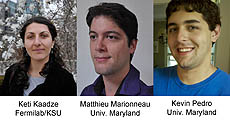Subatomic chimeras
 |
| In biology, a chimera is a creature whose cells contain the DNA, combined in utero, of two distinct individuals. In today's column, we describe leptoquarks, a hypothetical new particle that combines the properties of both quarks and leptons. |
In mythology, the chimera is a beast that is part lion, part snake and part goat. However, in modern times, the term has come to mean any organism that consists of cells from two distinct organisms. Inside the womb, two organisms merge when they consist of just a few cells. The result is kind of the opposite of identical twins. Rather than having two creatures with identical genetics, two creatures with distinct genetics merge to become a single organism.
There is a theoretical particle that could be said to be a chimera. In the Standard Model, there are two distinct classes of particles of matter. These are the quarks, which are typically found inside protons and neutrons, and leptons, of which the electron is the most familiar example. Quarks feel the electromagnetic and the strong and weak nuclear forces, while charged leptons feel the electromagnetic and weak forces. (The neutral leptons feel only the weak force.)
While it might not seem all that surprising that there are two classes of subatomic matter particles, this observation dampens the dreams of physicists who hope to be able to unify all phenomena and show that, ultimately, there is a single fundamental particle from which all other things derive. There is ample historical evidence that this unification is possible, for example the demonstration that the complicated world of chemistry stems from just a few particle species (protons, neutrons and electrons). Another simpler example is the very ordinary observation that water, ice and steam — all materials with very different properties — are really the same thing.
Perhaps there exists a particle called a leptoquark, which contains all of the properties of a quark and a lepton. In a sense, a leptoquark is a subatomic chimera. Note that the leptoquark is not generally accepted in particle physics, but neither has it been disproven.
In the Standard Model, we observe three "generations," with up and down quarks, electrons and electron neutrinos being generation number 1. Generation number 2 consists of charm and strange quarks and muons and muon neutrinos. Generation number 3 consists of top and bottom quarks and tau leptons and tau neutrinos. If leptoquarks exist, perhaps they respect the observed generations.
Accordingly, CMS physicists looked for third-generation leptoquarks. In the model that was tested, scientists searched for a hypothetical leptoquark that decayed into a bottom quark and tau lepton. The measurement was consistent with predictions of the Standard Model, which allowed researchers to set a stronger limit on this theoretical idea than had been available previously.
—Don Lincoln
 |
| These U.S. scientists contributed to this analysis. |
 |
| These Fermilab visiting engineers have made very significant contributions to CMS computing operations. Their home institutions are the Universidad San Francisco de Quito, Ecuador (John Artieda) and Universidad de los Andes, Bogota, Colombia (Luis Contreras, Jorge Diaz and Juan Mosquera). |
|